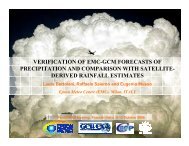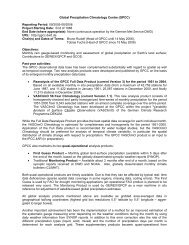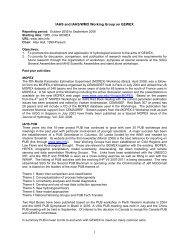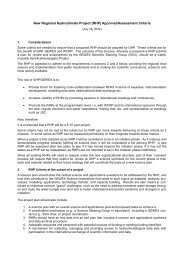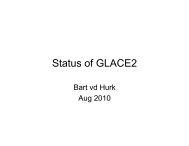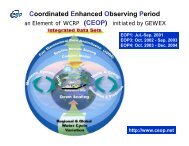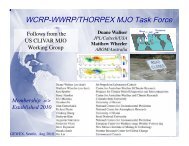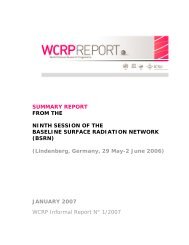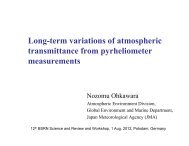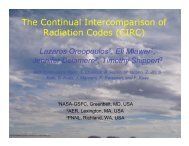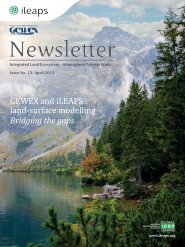Taiping Zhang – Processing of the BSRN Data and its ... - GEWEX
Taiping Zhang – Processing of the BSRN Data and its ... - GEWEX
Taiping Zhang – Processing of the BSRN Data and its ... - GEWEX
You also want an ePaper? Increase the reach of your titles
YUMPU automatically turns print PDFs into web optimized ePapers that Google loves.
<strong>Taiping</strong> <strong>Zhang</strong> 1 , Paul W. Stackhouse, Jr. 2 , Shashi K. Gupta 1 ,<br />
Stephen J. Cox 1 , J. Colleen Mikovitz 1<br />
1. SSAI / NASA Langley Research Center !<br />
Hampton, Virginia, USA !<br />
2. NASA Langley Research Center!<br />
Hampton, Virginia, USA!<br />
The 12 th Biennial <strong>BSRN</strong> Scientific Review <strong>and</strong> Workshop<br />
01-03 August, 2012 Potsdam, Germany
Analysis <strong>of</strong> <strong>the</strong> original <strong>BSRN</strong> data before<br />
<strong>and</strong> after quality check;<br />
<strong>Processing</strong> <strong>of</strong> <strong>the</strong> data to generate<br />
3-hourly, 3-hourly-monthly, daily <strong>and</strong><br />
monthly means;<br />
Application <strong>of</strong> <strong>the</strong> processed data in<br />
validating <strong>the</strong> <strong>GEWEX</strong> SRB(V3.0) data;<br />
Trend analysis;<br />
Conclusions.<br />
2
Quality Flags for <strong>the</strong> <strong>BSRN</strong> <strong>Data</strong>:<br />
01. Physically possible limit <strong>of</strong> G 1 (Global 1, or DIR+DIF);<br />
02. Extremely rare lim<strong>its</strong> <strong>of</strong> G 1 ;<br />
03. Physically possible limit <strong>of</strong> I DIR (DIRECT SW) radiation;<br />
04. Extremely rare lim<strong>its</strong> <strong>of</strong> I DIR radiation;<br />
05. Physically possible limit <strong>of</strong> I DIF (DIFFUSE) radiation;<br />
06. Extremely rare lim<strong>its</strong> <strong>of</strong> I DIF radiation;<br />
07. Physically possible limit <strong>of</strong> I LW (DOWNWARD LW) radiation;<br />
08. Extremely rare lim<strong>its</strong> <strong>of</strong> I LW radiation;<br />
09. Comparison <strong>of</strong> G 1 <strong>and</strong> G 2 (Global 2) ;<br />
10. Comparison between I DIF <strong>and</strong> G 1 radiation;<br />
11. I LW to AIR TEMPERATURE comparison.<br />
The values <strong>and</strong> meanings <strong>of</strong> <strong>the</strong> Quality Flags are as<br />
follows:<br />
• 2: Suspected to be erroneous;<br />
• 5: Cannot be performed;<br />
• 9: Passed <strong>the</strong> procedure.
Logical Procedure to Reject “Bad” Values:<br />
• If ei<strong>the</strong>r Flag 01 or Flag 02 has value “2”, <strong>the</strong>n G 1 is rejected;<br />
• If ei<strong>the</strong>r Flag 03 or Flag 04 has value “2”, <strong>the</strong>n I DIR <strong>and</strong> G 1 are rejected;<br />
• If ei<strong>the</strong>r Flag 05 or Flag 06 has value “2”, <strong>the</strong>n I DIF <strong>and</strong> G 1 are rejected;<br />
• If ei<strong>the</strong>r Flag 07 or Flag 08 or Flag 11 has value “2”, <strong>the</strong>n I LW is rejected;<br />
• If Flag 09 has value “2” <strong>and</strong> G 1 >0, <strong>the</strong>n G 2 is rejected;<br />
• If Flag 10 has value “2”, <strong>the</strong>n I DIF <strong>and</strong> G 1 are rejected.<br />
8
15-Minute Mean: requiring at least 1 x-minute value;<br />
Hourly Mean: from 4 valid 15-minute means;<br />
Hourly-Monthly Mean: requiring at least 1 day with<br />
valid hourly mean for <strong>the</strong> corresponding hour;<br />
3-Hourly Mean: from 3 valid hourly means;<br />
3-Hourly-Monthly Mean: requiring at least 1 day with<br />
valid 3-hourly mean for <strong>the</strong> corresponding time;<br />
Daily Mean: from hourly means, with up to 5 or 12 hours<br />
<strong>of</strong> ei<strong>the</strong>r cosine or linear interpolations depending on <strong>the</strong><br />
variable <strong>and</strong> latitude;<br />
Monthly Mean: i.) from daily means, requiring at least 1<br />
daily mean in <strong>the</strong> month; ii.) from 24 valid hourly-monthly<br />
means.<br />
12
Daily Mean<br />
14
Monthly Mean<br />
15
Bias<br />
(W m -2 )<br />
RMS<br />
(W m -2 )<br />
σ<br />
(Wm -2 )<br />
ρ<br />
N<br />
G 1<br />
-6.99 88.32 88.05 0.9475 597867<br />
G 2<br />
-4.39 88.13 88.02 0.9474 697862<br />
Blended -4.96 88.38 88.24 0.9465 716742<br />
17
SRB(V3.0)-<strong>BSRN</strong> SW Daily <strong>and</strong> Monthly Mean Comparisons<br />
Daily<br />
Monthly<br />
22
SRB(V3.0)-<strong>BSRN</strong> LW Daily <strong>and</strong> Monthly Mean Comparisons<br />
Daily<br />
Monthly<br />
23
<strong>GEWEX</strong> SRB(V3.0)-<strong>BSRN</strong> Comparison<br />
Bias/(RMS) from 1992-01 to 2007-12!<br />
<strong>BSRN</strong> SW G 1 Used with <strong>the</strong> Laxest Availability Control!<br />
Model<br />
3-Hourly<br />
(W m -2 )<br />
Daily<br />
(W m -2 )<br />
3-Hourly-<br />
Monthly<br />
(W m -2 )<br />
Monthly<br />
(W m -2 )<br />
<strong>GEWEX</strong> SRB<br />
GSW(V3.0)<br />
-6.99<br />
(88.32)<br />
-3.58<br />
(35.50)<br />
-8.81<br />
(47.43)<br />
-5.22<br />
(23.34)<br />
<strong>GEWEX</strong> SRB<br />
GLW(V3.0)<br />
1.25<br />
(30.50)<br />
1.13<br />
(22.16)<br />
0.89<br />
(13.75)<br />
0.97<br />
(11.18)<br />
<strong>BSRN</strong> data from http://bsrn.awi.de/ as <strong>of</strong> 2011-08-22.
Dependence on Choice <strong>of</strong> Time Period<br />
<strong>BSRN</strong><br />
SRB<br />
References<br />
• Wea<strong>the</strong>rhead, E.C. et al., 1998. JGR, 103(D14), 17,149-17,161.<br />
• Hinkelman, L.M., et al., 2009. JGR, 114, D00D20, doi:10.1029/2008JD011004.<br />
• Liebmann, B., 2010. BAMS, November, 2010, 1485-1491.<br />
27
Dependence on Choice <strong>of</strong> Time Period<br />
Positive Trend<br />
<strong>BSRN</strong><br />
SRB<br />
28
Dependence on Choice <strong>of</strong> Time Period<br />
Negative Trend<br />
<strong>BSRN</strong><br />
SRB<br />
29
As <strong>of</strong> August 2011, <strong>the</strong>re are 5969 site-months <strong>of</strong> <strong>BSRN</strong><br />
data in archive from 48 <strong>of</strong> 52 <strong>BSRN</strong> sites, spanning a<br />
period <strong>of</strong> 19 years <strong>and</strong> 7 months beginning from January,<br />
1992;<br />
<br />
Quality-flags are produced based on <strong>the</strong> methodology by<br />
ETH <strong>and</strong> Long <strong>and</strong> Shi (2008). About 4% <strong>of</strong> <strong>the</strong> original<br />
records are rejected through quality-check;<br />
<br />
About 25% <strong>of</strong> <strong>the</strong> sites show G 2 -G 1 RMS errors above 25 up<br />
to 54 Wm -2 . After quality check, all but one RMS errors<br />
reduce to below 20 Wm -2 . The G 2 -G 1 bias error change is<br />
not as dramatic except for ILO, FLO <strong>and</strong> DAA;<br />
<br />
The site ILO has problems with G 1 , but <strong>its</strong> G 2 <strong>and</strong> longwave<br />
values appear to be normal, as <strong>the</strong>y agree with <strong>the</strong>ir<br />
<strong>GEWEX</strong> SRB counterparts reasonably well;<br />
30
SYO <strong>and</strong> GVN tend to be outliers in <strong>the</strong> SRB-<strong>BSRN</strong> shortwave<br />
comparisons. This might be resulted from <strong>the</strong> questionable satellitebased<br />
cloud identification over <strong>the</strong> snow-covered Antarctica;<br />
The G 2 values at NYA, PAY, KWA, GVN <strong>and</strong> SPO are continuously<br />
available for a 15-year period from 1993-01 to 2007-12. The<br />
Wea<strong>the</strong>rhead et al. (1998) method was used to determine <strong>the</strong> 95%<br />
confidence intervals <strong>of</strong> trends <strong>of</strong> <strong>the</strong>se sites <strong>and</strong> <strong>of</strong> <strong>the</strong>ir ensemble<br />
average. The chosen time period for <strong>the</strong> trend detection ranges from<br />
2 to 15 years. Over <strong>the</strong> 15-year period, <strong>the</strong> <strong>BSRN</strong> ensemble average<br />
shows no significant positive or negative trend, but <strong>its</strong> SRB<br />
counterpart shows a negative trend <strong>of</strong> very small magnitude.<br />
Considering <strong>the</strong> uncertainties in <strong>the</strong> SRB data, no conclusions can<br />
be made about <strong>the</strong>se trends.<br />
31
For More Information about <strong>GEWEX</strong> SRB:<br />
http://gewex-srb.larc.nasa.gov<br />
<strong>Taiping</strong>.<strong>Zhang</strong>@NASA.gov<br />
The 12 th Biennial <strong>BSRN</strong> Scientific Review <strong>and</strong> Workshop!<br />
01-03 August, 2012. Potsdam, Germany



